实验三:类和对象
实验任务一:
源码:

#include <iostream> #include <string> class Button { public: Button(const std::string &label_); const std::string& get_label() const; //‘&’不是函数的引用,而是一个“返回值为const std::string&的成员函数” void click(); private: std::string label; }; Button::Button(const std::string &label_): label{label_}{ } inline const std::string& Button::get_label() const{ return label; } inline void Button::click(){ std::cout << "Button '" << label << "' clicked\n"; }

#pragma once #include <iostream> #include <vector> #include <algorithm> #include "button.hpp" class window{ public: window(const std::string &title_); void display() const; void close(); void add_button(const std::string &label); void click_button(const std::string &label); private: bool has_button(const std::string &label) const; private: std::string title; std::vector<Button> buttons; }; window::window(const std::string &title_):title{title_}{ buttons.push_back(Button("close")); //<vector>中push_back:向vector容器末尾添加一个标签为"close"的Button对象 } inline void window::display() const { std::string s(40,'*'); std::cout << s << std::endl; std::cout << s << std::endl; std::cout << "window: " << title << std::endl; int cnt = 0; for(const auto &button: buttons) //for(元素声明:可遍历对象)//&引用,直接操作容器里的原始元素,减少内存浪费 std::cout << ++cnt << ". " << button.get_label() << std::endl; std::cout << s << std::endl; } inline void window::close(){ std::cout << "close window '" << title << "'" << std::endl; click_button("close"); } inline bool window::has_button(const std::string &label) const { for(const auto &button: buttons) if(button.get_label() == label) return true; return false; } inline void window::add_button(const std::string &label){ if(has_button(label)) std::cout << "button" << label << "already exists!\n"; else buttons.push_back(Button(label)); } inline void window::click_button(const std::string &label){ for(auto &button:buttons) if(button.get_label() == label){ button.click(); return; } std::cout << "no button: " << label << std::endl; }

#include "window.hpp" #include <iostream> void test(){ window w("Demo"); w.add_button("add"); w.add_button("remove"); w.add_button("modify"); w.add_button("add"); w.display(); w.close(); } int main(){ std::cout << "用组合类模拟简单GUI:\n"; test(); }
运行结果测试截图:
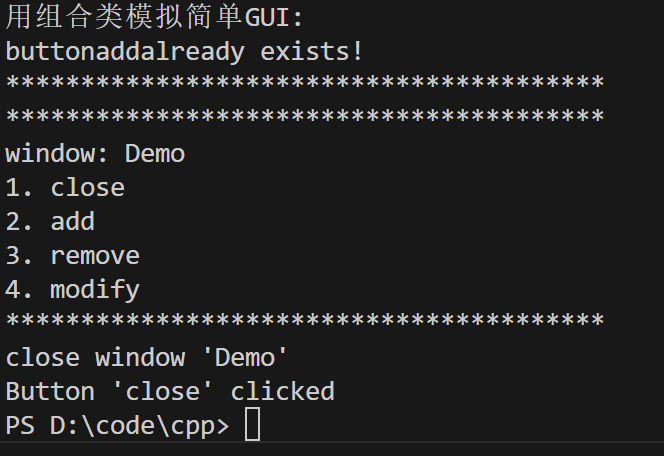
回答问题:
- 问题1:这个范例中, Window 和 Button 是组合关系吗?
答:Window和Button是组合关系。
- 问题2:bool has_button(const std::string &label) const; 被设计为私有。
思考并回答:(1)若将其改为公有接口,有何优点或风险?
(2)设计类时,如何判断一个成员函数应为 public 还是 private?(可从“用户是否需要”、“是否仅为内部实现细节”、“是否易破坏对象状态”等角度分析。)
答:(1)若将其改为公有接口,优点:用户可以查看窗口是否有指定标签的按钮;缺点:把类的内部暴露给了外部,如果有外部调用者基于这个接口做了一些操作,只要这个接口内部发生修改,就可能影响所有基于这个接口的外部代码。
(2)①用户是否需要:如果成员函数是用户必须要使用的接口,应为public。
②是否仅为内部实现细节:如果成员函数只是实现类内部的细节部分设为private即可。
③是否易破坏对象状态:如果用户在使用成员函数时可能会修改成员函数(破坏对象状态)导致类内部逻辑错误则应设为private。
- 问题3:Button 的接口 const std::string& get_label() const; 返回 const std::string& 。简要说明以下两种接口设计在性能和安全性方面的差异。
接口1: const std::string& get_label() const; 接口2: const std::string get_label() const;
答:两种接口差别主要是接口1中有'&',表示返回的值是引用类型(返回引用),可以直接传递参数不会创建副本,减少内存占据,结合get_label在后续定义中加了inline内联函数定义,可以进一步判断接口1是想提高代码的简洁性和高效性,性能更强。安全性方面,我仍然觉得接口1的安全性更强,因为加了const,所以接口1返回的是const引用,不会修改原对象;而接口2是返回拷贝,会生成返回值的副本,额外增加了开销,性能较弱。同时接口2也有const保护,没有安全性的优势,同时拷贝本身可能引入额外的风险。
- 问题4:把代码中所有 xx.push_back(Button(xxx)) 改成 xx.emplace_back(xxx) ,观察程序是否正常运行;查阅资料,回答两种写法的差别。
答:修改了25行和56行处push_back,程序正常运行。查阅资料后,push_back会先对对象进行拷贝操作,然后把副本加入vector中,而emplace_back直接把参数传入构造函数中。核心区别是push_back接收已经构造好的对象,而emplace_back原地构造。所以在这里我认为可以修改一下代码,不需要创建Button类的对象再调用函数,可以直接写成buttons.emplace_back("close");。
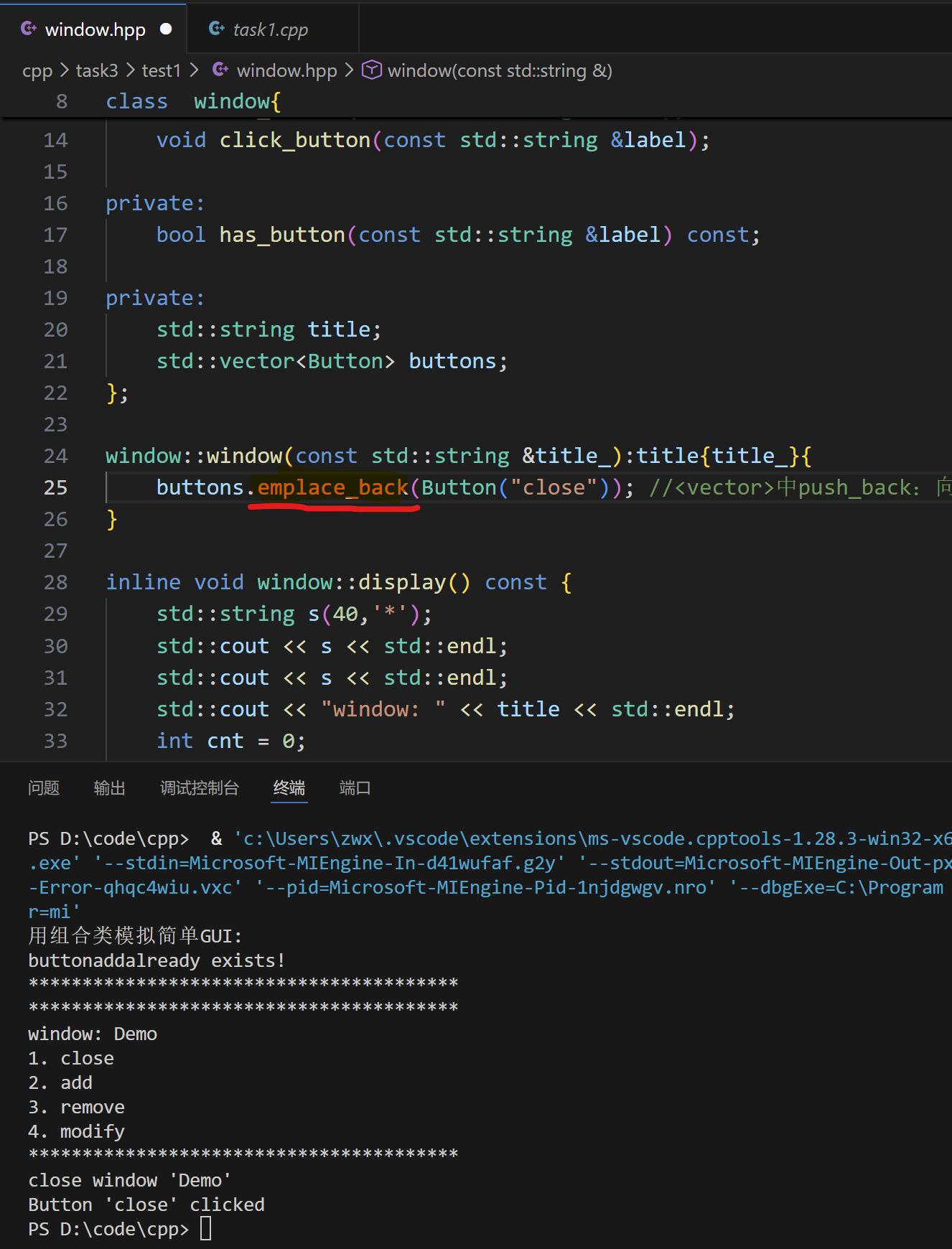
实验任务二:
源码:

#include <iostream> #include <vector> void test1(); void test2(); void output1(const std::vector<int> &v); void output2(const std::vector<int> &v); void output3(const std::vector<std::vector<int>>& v); int main(){ std::cout << "深复制验证1:标准库vector<int>\n"; test1(); std::cout << "\n深复制验证2:标准库vector<int>嵌套使用\n"; test2(); } void test1(){ std::vector<int> v1(5,42); const std::vector<int> v2(v1); std::cout << "*********拷贝构造后***********\n"; std::cout << "v1: ";output1(v1); std::cout << "v2: ";output1(v2); v1.at(0) = -1; std::cout << "*********修改v1[0]后**********\n"; std::cout << "v1: ";output1(v1); std::cout << "v2: ";output1(v2); } void test2(){ std::vector<std::vector<int>> v1{{1,2,3},{4,5,6,7}}; const std::vector<std::vector<int>> v2(v1); std::cout << "**********拷贝构造后************\n"; std::cout << "v1: "; output3(v1); std::cout << "v2: "; output3(v2); v1.at(0).push_back(-1); std::cout << "*********修改v1[0]后**********\n"; std::cout << "v1: \n"; output3(v1); std::cout << "v2: \n"; output3(v2); } //使用xx.at()+循环输出vector<int>数据项 void output1(const std::vector<int> &v) { if(v.size() == 0) { std::cout << '\n'; return; } std::cout << v.at(0); for(auto i = 1;i < v.size();++i) std::cout << ", " <<v.at(i); std::cout << '\n'; } //使用迭代器+循环输出vector<int>数据项 void output2(const std::vector<int> &v) { if(v.size() == 0) { std::cout << '\n'; return; } auto it = v.begin(); std::cout << *it; for(it = v.begin()+1;it != v.end();++it) std::cout << ", " << *it; std::cout << '\n'; } //使用auto for分行输出vector<vector<int>>数据项 void output3(const std::vector<std::vector<int>>& v) { if(v.size() == 0) { std::cout << '\n'; return; } for(auto &i:v) output2(i); }
运行结果测试截图:
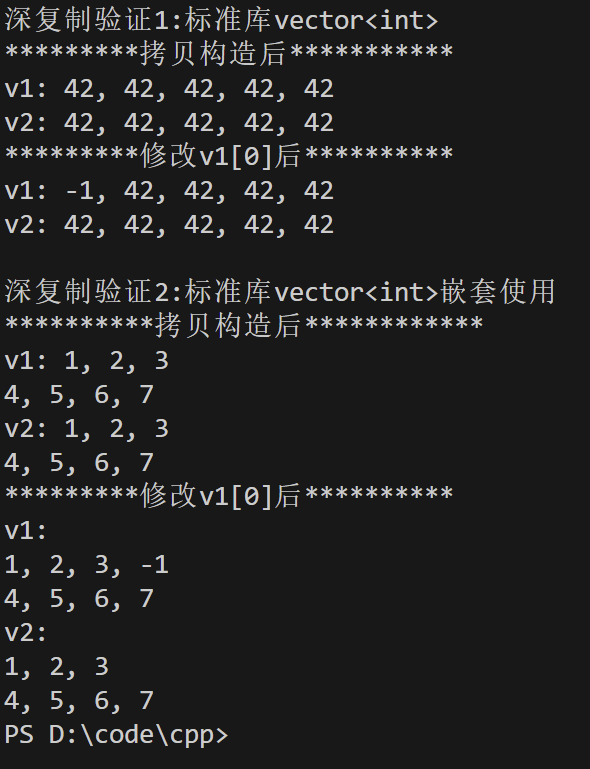
回答问题:
- 问题1:测试模块1中这两行代码分别完成了什么构造? v1 、 v2 各包含多少个值为 42 的数据项?

答:第一行调用vector中填充构造函数完成了成员为int型的vector v1的构造,vector中包含5个元素,每个元素的值都为42。第二行通过调用vector中拷贝构造函数复制v1中所有元素完成v2的构造,并且加了const保护,不可修改v2中的值,以完成后续深复制验证;v1和v2都包含5个值为42的数据项。
- 问题2:测试模块2中这两行代码执行后, v1.size() 、 v2.size() 、 v1[0].size() 分别是多少?

答:v1.size() = 2, v2.size() = v1.size() = 2, v1[0].size() = 3。vector<int>嵌套使用时,对于外层vector, .size()表示其内部vector个数,对于内层vector, [i].size()表示其内部第i个vector包含的int元素个数。
- 问题3:测试模块1中,把 v1.at(0) = -1; 写成 v1[0] = -1; 能否实现同等效果?两种用法有何区别?
答:能实现同等效果。通过查阅资料,我了解到.at()是容器类的一个成员函数,可以根据索引或键从容器中获取对象。但是.at()和直接用[i]下标索引的核心区别是.at()有边界检查功能,如果超出检索范围,它会提示std::out_of_range而不是报错,可以有效地提示错误。
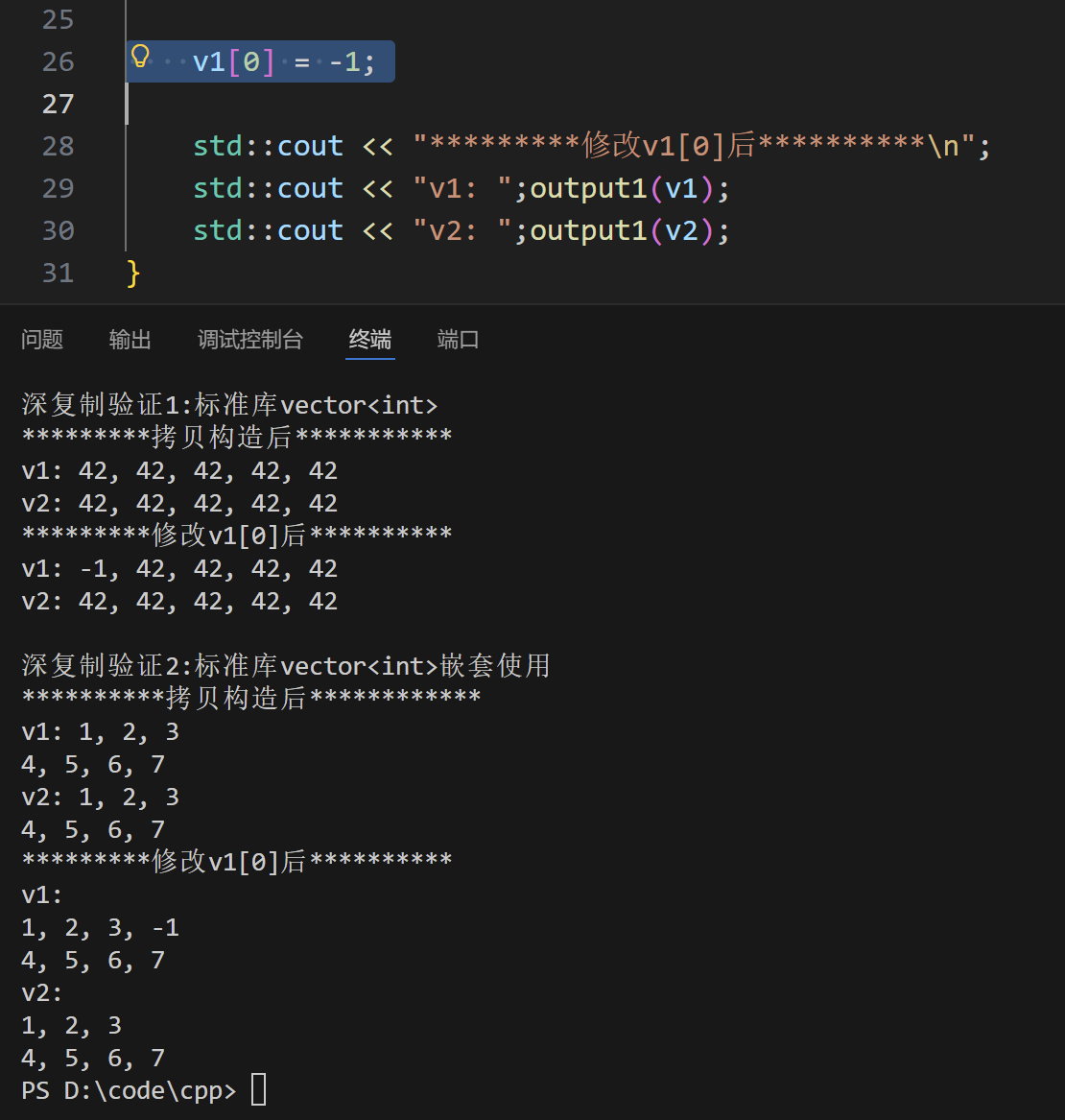
- 问题4:测试模块2中执行 v1.at(0).push_back(-1); 后
(1)用以下两行代码,能否输出-1?为什么?

答:可以输出-1,因为在嵌套vector使用时,v1.at(0)访问的是嵌套vector中第一个内部子vector,而r是这个子vector的引用,因为上面执行了push_back,所以子vector的size变为了4,通过r.at(4-1)访问就能输出-1。
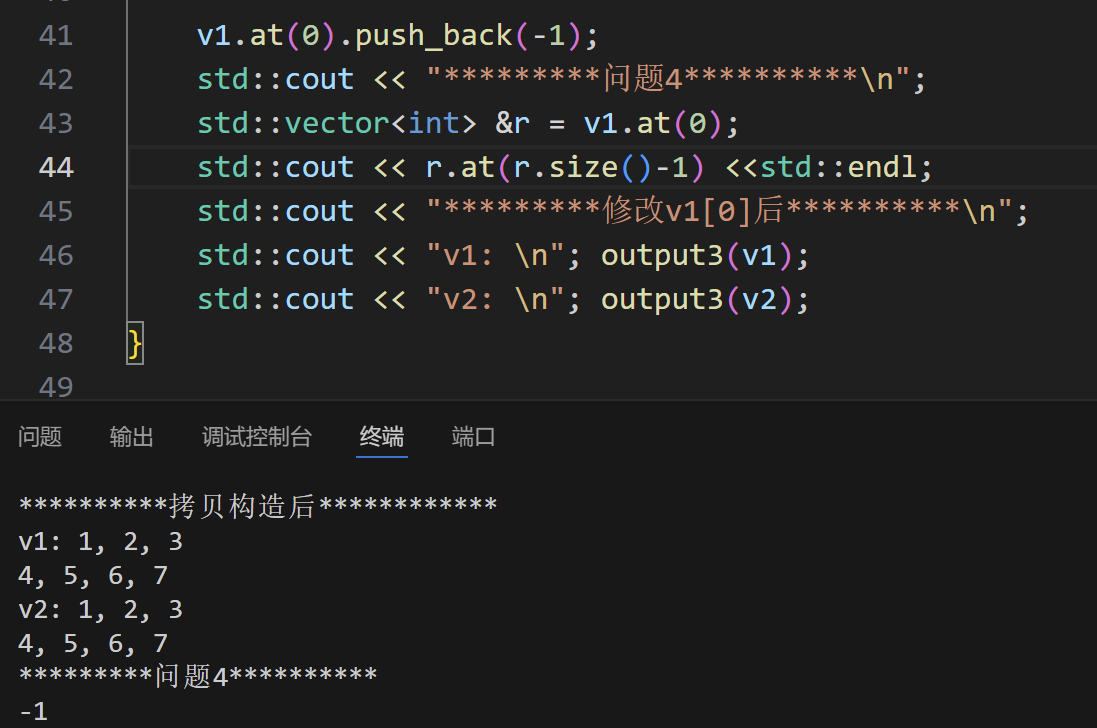
(2)r定义成用 const & 类型接收返回值,在内存使用上有何优势?有何限制?
答:r加上const修饰变为const &是常量引用,起到了通过该引用不能修改对象的作用,可以避免不必要的拷贝,但同时也限制了这个子vector后续无法修改元素。
- 问题5:观察程序运行结果,反向分析、推断:
(1)标准库模板类 vector 的复制构造函数实现的是深复制还是浅复制?
答:深复制。对v1的修改不会影响v2。
(2)vector::at() 接口思考:当 v 是 vector 时,v.at(0) 返回值类型是什么?当 v 是 const vector 时,v.at(0) 返回值类型又是什么?据此推断 .at() 是否必须提供带 const 修饰的重载版本?
答:当 v 是 vector 时,v.at(0) 返回值类型是对应元素的&引用,通过它可以直接修改元素;当 v 是 const vector 时,v.at(0) 返回值类型是const &常量引用,不允许通过它修改元素;据此推断.at()必须提供带const类型的重载版本,因为当操作const类型的vector时需要调用const的at()接口以确保类型匹配,保证安全访问。
实验任务三:
源码:

#pragma once #include <iostream> // 动态int数组对象类 class vectorInt{ public: vectorInt(); vectorInt(int n_); vectorInt(int n_, int value); vectorInt(const vectorInt &vi); ~vectorInt(); int size() const; int& at(int index); const int& at(int index) const; vectorInt& assign(const vectorInt &vi); int* begin(); int* end(); const int* begin() const; const int* end() const; private: int n; // 当前数据项个数 int *ptr; // 数据区 }; vectorInt::vectorInt():n{0}, ptr{nullptr} { } vectorInt::vectorInt(int n_): n{n_}, ptr{new int[n]} { } vectorInt::vectorInt(int n_, int value): n{n_}, ptr{new int[n_]} { for(auto i = 0; i < n; ++i) ptr[i] = value; } vectorInt::vectorInt(const vectorInt &vi): n{vi.n}, ptr{new int[n]} { for(auto i = 0; i < n; ++i) ptr[i] = vi.ptr[i]; } vectorInt::~vectorInt() { delete [] ptr; } int vectorInt::size() const { return n; } const int& vectorInt::at(int index) const { if(index < 0 || index >= n) { std::cerr << "IndexError: index out of range\n"; std::exit(1); } return ptr[index]; } int& vectorInt::at(int index) { if(index < 0 || index >= n) { std::cerr << "IndexError: index out of range\n"; std::exit(1); } return ptr[index]; } vectorInt& vectorInt::assign(const vectorInt &vi) { if(this == &vi) return *this; int *ptr_tmp; ptr_tmp = new int[vi.n]; for(int i = 0; i < vi.n; ++i) ptr_tmp[i] = vi.ptr[i]; delete[] ptr; n = vi.n; ptr = ptr_tmp; return *this; } int* vectorInt::begin() { return ptr; } int* vectorInt::end() { return ptr+n; } const int* vectorInt::begin() const { return ptr; } const int* vectorInt::end() const { return ptr+n; }

#include "vectorInt.hpp" #include <iostream> void test1(); void test2(); void output1(const vectorInt &vi); void output2(const vectorInt &vi); int main() { std::cout << "测试1: \n"; test1(); std::cout << "\n测试2: \n"; test2(); } void test1() { int n; std::cout << "Enter n: "; std::cin >> n; vectorInt x1(n); for(auto i = 0; i < n; ++i) x1.at(i) = (i+1)*10; std::cout << "x1: "; output1(x1); vectorInt x2(n, 42); vectorInt x3(x2); x2.at(0) = -1; std::cout << "x2: "; output1(x2); std::cout << "x3: "; output1(x3); } void test2() { const vectorInt x(5, 42); vectorInt y; y.assign(x); std::cout << "x: "; output2(x); std::cout << "y: "; output2(y); } // 使用xx.at()+循环输出vectorInt对象数据项 void output1(const vectorInt &vi) { if(vi.size() == 0) { std::cout << '\n'; return; } std::cout << vi.at(0); for(auto i = 1; i < vi.size(); ++i) std::cout << ", " << vi.at(i); std::cout << '\n'; } // 使用迭代器+循环输出vectorInt对象数据项 void output2(const vectorInt &vi) { if(vi.size() == 0) { std::cout << '\n'; return; } auto it = vi.begin(); std::cout << *it; for(it = vi.begin()+1; it != vi.end(); ++it) std::cout << ", " << *it; std::cout << '\n'; }
运行结果测试截图:
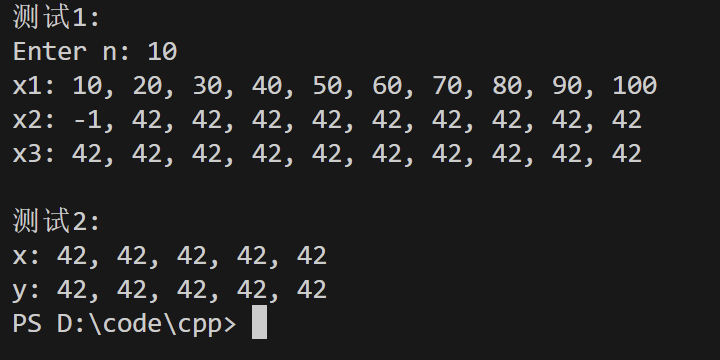
回答问题:
- 问题1:当前验证性代码中, vectorInt 接口 assign 实现是安全版本。如果把 assign 实现改成版本2, 逐条指出版本2存在的安全隐患和缺陷。(提示:对比两个版本,找出差异化代码,加以分析)
//版本1 vectorInt& vectorInt::assign(const vectorInt &vi) { if(this == &vi) return *this; int *ptr_tmp; ptr_tmp = new int[vi.n]; for(int i = 0; i < vi.n; ++i) ptr_tmp[i] = vi.ptr[i]; delete[] ptr; n = vi.n; ptr = ptr_tmp; return *this; }
// 版本2 vectorInt& vectorInt::assign(const vectorInt &vi) { delete[] ptr; n = vi.n; ptr = new int[n]; for(int i = 0; i < n; ++i) ptr[i] = vi.ptr[i]; return *this; }
答:两个版本主要有两个核心差异,第一个是安全版本if(this == &vi) return *this;这个操作可以防止自赋值,如a.assign(a)所导致的内存错误问题;第二个差异是安全版本先进行赋值再修改指针指向的内存,而版本2先释放了原先指针内存然后再赋值,这样会导致逻辑错误内存分配不明确,不能清晰的判断是否是深复制。
- 问题2:当前验证性代码中,重载接口 at 内部代码完全相同。若把非 const 版本改成如下实现,可消除重复并遵循“最小化接口”原则(未来如需更新接口,只更新const接口,另一个会同步)。
int& vectorInt::at(int index) { return const_cast<int&>(static_cast<const vectorInt*>(this)->at(index)); }
查阅资料,回答:(1) static_cast(this) 的作用是什么?转换前后 this 的类型分别是什么?转换目的?
答:static_cast(tihs)把this指针的非const类型变为<const vectoInt>中的const类型,让非const对象能直接调用const at函数。
(2) const_cast<int&> 的作用是什么?转换前后的返回类型分别是什么?转换目的?
答:const_cast(this)把转换成const类型的this再恢复到非const的int &类型,以完成后续调用at函数时修改对应索引的值。
- 问题3: vectorInt 类封装了 begin() 和 end() 的const/非const接口。
(1)以下代码片段,分析编译器如何选择重载版本,并总结这两种重载分别适配什么使用场景。
vectorInt v1(5); const vectorInt v2(5); auto it1 = v1.begin(); // 调用哪个版本? auto it2 = v2.begin(); // 调用哪个版本?
答:v1调用非const版本,v2调用const版本。v1适合想要对vectorInt内部做修改时使用,v2适合仅查找不做修改时使用。
(2)拓展思考(选答*):标准库迭代器本质上是指针的封装。 vectorInt 直接返回原始指针作为迭代器,这种设计让你对迭代器有什么新的理解?
答:据我对标准库迭代器的了解,标准库迭代器适用于所有容器,本质上提供一种统一的元素访问方式,比如list,vector,array。其中像list链表它的内存是不连续的,通过迭代器仍然能够按序找到对应元素,但是我们自己封装的vectorInt本质上还是分配一片连续内存的数组,返回原始指针作为迭代器,因此像list这种存储结构是没法实现的。所以我觉得标准库迭代器是一种更加安全通用的原始指针的封装,可以完成一些原始指针物理上做不到的事情。
- 问题4:以下两个构造函数及 assign 接口实现,都包含内存块的赋值/复制操作。使用算法库改写是否可以?回答这3行更新代码的功能。
vectorInt::vectorInt(int n_, int value): n{n_}, ptr{new int[n_]} { std::fill_n(ptr, n, value); // 更新 } vectorInt::vectorInt(const vectorInt &vi): n{vi.n}, ptr{new int[n]} { std::copy_n(vi.ptr, vi.n, ptr); // 更新 } vectorInt& vectorInt::assign(const vectorInt &vi) { if(this == &vi) return *this; int *ptr_tmp; ptr_tmp = new int[vi.n]; std::copy_n(vi.ptr, vi.n, ptr_tmp); // 更新 delete[] ptr; n = vi.n; ptr = ptr_tmp; return *this; }
答:这三行更新的代码结构可以抽象成fill(i,j,n),copy(i,n,ptr),fill想实现的是从i到j用n填满,从而实现内存块的赋值操作;copy想做的是从i中复制n个元素到ptr指向的内存区域,从而实现内存块的复制操作。可以使用算法库改写,这样算法函数封装了内存赋值/复制操作的逻辑,让代码更加简洁可读。
实验任务四:
源码:

#include <iostream> #include <cstdlib> #include "matrix.hpp" void test1(); void test2(); void output(const Matrix &m, int row_index); int main() { std::cout << "测试1: \n"; test1(); std::cout << "\n测试2: \n"; test2(); } void test1() { double x[1000] = {1, 2, 3, 4, 5, 6, 7, 8, 9, 10}; int n, m; std::cout << "Enter n and m: "; std::cin >> n >> m; Matrix m1(n, m); // 创建矩阵对象m1, 大小n×m m1.set(x, n*m); // 用一维数组x的值按行为矩阵m1赋值 Matrix m2(m, n); // 创建矩阵对象m2, 大小m×n m2.set(x, m*n); // 用一维数组x的值按行为矩阵m1赋值 Matrix m3(n); // 创建一个n×n方阵对象 m3.set(x, n*n); // 用一维数组x的值按行为矩阵m3赋值 std::cout << "矩阵对象m1: \n"; m1.print(); std::cout << "矩阵对象m2: \n"; m2.print(); std::cout << "矩阵对象m3: \n"; m3.print(); } void test2() { Matrix m1(2, 3, -1); const Matrix m2(m1); std::cout << "矩阵对象m1: \n"; m1.print(); std::cout << "矩阵对象m2: \n"; m2.print(); m1.clear(); m1.at(0, 0) = 1; std::cout << "m1更新后: \n"; std::cout << "矩阵对象m1第0行 "; output(m1, 0); std::cout << "矩阵对象m2第0行: "; output(m2, 0); } // 输出矩阵对象row_index行所有元素 void output(const Matrix &m, int row_index) { if(row_index < 0 || row_index >= m.rows()) { std::cerr << "IndexError: row index out of range\n"; exit(1); } std::cout << m.at(row_index, 0); for(int j = 1; j < m.cols(); ++j) std::cout << ", " << m.at(row_index, j); std::cout << '\n'; }

#pragma once #include <iostream> #include <algorithm> #include <cstdlib> // 类Matrix声明 class Matrix { public: Matrix(int rows_, int cols_, double value = 0); // 构造rows_*cols_矩阵对象, 初值value Matrix(int rows_, double value = 0); // 构造rows_*rows_方阵对象, 初值value Matrix(const Matrix &x); // 深复制 ~Matrix(); void set(const double *pvalue, int size); // 按行复制pvalue指向的数据,要求size=rows*cols,否则报错退出 void clear(); // 矩阵对象数据项置0 const double& at(int i, int j) const; // 返回矩阵对象索引(i,j)对应的数据项const引用(越界则报错后退出) double& at(int i, int j); // 返回矩阵对象索引(i,j)对应的数据项引用(越界则报错后退出) int rows() const; // 返回矩阵对象行数 int cols() const; // 返回矩阵对象列数 void print() const; // 按行打印数据 private: int n_rows; // 矩阵对象内元素行数 int n_cols; // 矩阵对象内元素列数 double *ptr; // 数据区 };

#include "matrix.hpp" Matrix::Matrix(int rows_, int cols_, double value):n_rows{rows_},n_cols{cols_}{ if(n_rows < 0 || n_cols < 0) { std::cout << "行数/列数不能为负数!\n" << std::endl; ptr = nullptr; return; } ptr = new double[n_rows *n_cols]; for(int i = 0;i < n_rows*n_cols;i++) ptr[i] = value; } Matrix::Matrix(int rows_, double value):n_rows{rows_},n_cols{rows_}{ if(n_rows < 0 || n_cols < 0) { std::cout << "行数/列数不能为负数!\n" << std::endl; ptr = nullptr; return; } ptr = new double[n_rows *n_cols]; for(int i = 0;i < n_rows*n_rows;i++) ptr[i] = value; } Matrix::Matrix(const Matrix &x):n_rows{x.n_rows},n_cols{x.n_cols}{ if(n_rows < 0 || n_cols < 0) { std::cout << "行数/列数不能为负数!\n" << std::endl; ptr = nullptr; return; } ptr = new double[n_rows *n_cols]; for(int i = 0;i < n_rows*n_cols;i++) ptr[i] = x.ptr[i]; } Matrix::~Matrix(){ delete []ptr; } // 按行复制pvalue指向的数据,要求size=rows*cols,否则报错退出 void Matrix::set(const double *pvalue, int size){ if(size != n_rows*n_cols) std::cout << "out of size!\n" << std::endl; std::copy(pvalue,pvalue + size,ptr); } // 矩阵对象数据项置0 void Matrix::clear(){ std::fill(ptr,ptr + n_rows*n_cols,0.0); } // 返回矩阵对象索引(i,j)对应的数据项const引用(越界则报错后退出) const double& Matrix::at(int i, int j) const{ if(i > n_rows || j > n_cols) { std::cout << "out of range!\n" << std::endl; exit(EXIT_FAILURE); } return ptr[i * n_cols + j]; } // 返回矩阵对象索引(i,j)对应的数据项引用(越界则报错后退出) double& Matrix::at(int i,int j){ if(i > n_rows || j > n_cols) { std::cout << "out of range!\n" << std::endl; exit(EXIT_FAILURE); } return ptr[i * n_cols + j]; } int Matrix::rows() const{ return n_rows; } int Matrix::cols() const{ return n_cols; } void Matrix::print() const{ for(int i = 0;i < n_rows;i++) { std::cout << ptr[i * n_cols]; for(int j = 1;j < n_cols;j++) { std::cout << ", " << ptr[i * n_cols + j]; } std::cout << "\n"; } }
运行结果测试截图:

实验任务五:
源码:

#pragma once #include <iostream> #include <string> // 联系人类 class Contact { public: Contact(const std::string &name_, const std::string &phone_); const std::string &get_name() const; const std::string &get_phone() const; void display() const; private: std::string name; // 必填项 std::string phone; // 必填项 }; Contact::Contact(const std::string &name_, const std::string &phone_):name{name_}, phone{phone_} { } const std::string& Contact::get_name() const { return name; } const std::string& Contact::get_phone() const { return phone; } void Contact::display() const { std::cout << name << ", " << phone; }

# pragma once #include <iostream> #include <string> #include <vector> #include <algorithm> #include "contact.hpp" // 通讯录类 class ContactBook { public: void add(const std::string &name, const std::string &phone); // 添加联系人 void remove(const std::string &name); // 移除联系人 void find(const std::string &name) const; // 查找联系人 void display() const; // 显示所有联系人 size_t size() const; private: int index(const std::string &name) const; // 返回联系人在contacts内索引,如不存在,返回-1 void sort(); // 按姓名字典序升序排序通讯录 private: std::vector<Contact> contacts; }; void ContactBook::add(const std::string &name, const std::string &phone) { if(index(name) == -1) { contacts.push_back(Contact(name, phone)); std::cout << name << " add successfully.\n"; sort(); return; } std::cout << name << " already exists. fail to add!\n"; } void ContactBook::remove(const std::string &name) { int i = index(name); if(i == -1) { std::cout << name << " not found, fail to remove!\n"; return; } contacts.erase(contacts.begin()+i); std::cout << name << " remove successfully.\n"; } void ContactBook::find(const std::string &name) const { int i = index(name); if(i == -1) { std::cout << name << " not found!\n"; return; } contacts[i].display(); std::cout << '\n'; } void ContactBook::display() const { for(auto &c: contacts) { c.display(); std::cout << '\n'; } } size_t ContactBook::size() const { return contacts.size(); } // 待补足1:int index(const std::string &name) const;实现 // 返回联系人在contacts内索引; 如不存在,返回-1 int ContactBook::index(const std::string &name) const{ for(int i = 0;i < contacts.size();i++) { std::string get_name = contacts[i].get_name(); if(name == get_name) return i; } return -1; } // 待补足2:void ContactBook::sort();实现 // 按姓名字典序升序排序通讯录 void ContactBook::sort(){ //使用sort,内部使用lambda表达式对contact类自定义比较 //lambda表达式:[capture](parameters) -> return_type{//函数体(执行逻辑} std::sort(contacts.begin(),contacts.end(),[](const Contact&a,const Contact&b){return a.get_name() < b.get_name();}); }

#include "contactBook.hpp" void test() { ContactBook contactbook; std::cout << "1. add contacts\n"; contactbook.add("Bob", "18199357253"); contactbook.add("Alice", "17300886371"); contactbook.add("Linda", "18184538072"); contactbook.add("Alice", "17300886371"); std::cout << "\n2. display contacts\n"; std::cout << "There are " << contactbook.size() << " contacts.\n"; contactbook.display(); std::cout << "\n3. find contacts\n"; contactbook.find("Bob"); contactbook.find("David"); std::cout << "\n4. remove contact\n"; contactbook.remove("Bob"); contactbook.remove("David"); } int main() { test(); }
运行结果测试截图:







 浙公网安备 33010602011771号
浙公网安备 33010602011771号